 TRIZ/USIT/CrePS Paper TRIZ/USIT/CrePS Paper |

 
|
General methodology for creative problem solving and task achieving (CrePS): Its vision |
| Toru Nakagawa (Osaka Gakuin University, Professor Emeritus)
|
| 13th ETRIA TRIZ Future Conference (TFC2013), to be held on Oct. 29-31, 2013, Ecole Nationale d'Arts et Metiers of Paris, Paris, France |
In the Japanese page: (same title)
to be presented at the 35th Conference of Japan Creativity Society,
on Oct. 26-27, 2013 at Nihon Institute of Medical Science,
Moroyama-machi, Saitama |
Posted: Oct. 3, 2013; Updated: Oct. 25, 2013 (Slides are posted) |
For going back to Japanese pages, press  buttons.
buttons.
 Editor's Note (Toru Nakagawa, Sept. 28, 2013)
Editor's Note (Toru Nakagawa, Sept. 28, 2013)
This page posts a full paper on the 'General methodology of Creative Problem Solving and Task Achieving (CrePS)', which I have been adovocating these days, with the focus on its vision.
I have submitted a paper in Japanese to be presented at the Conference of Japan Creativity Society on Oct. 26-27, and another in English, having the same title, to be presented at ETRIA TFC 2013 on Oct. 29-31 in Paris.
I have not prepared the presentation slides yet.
The Japanese paper for JCS Conference is addessed to the audience who are working for creativity education, practical applications of problem solving techniques, etc. (with few people familiar with TRIZ), and hence it emphasizes on the needs of unifying various creative problem solving methods into a general methodology. On the other hand, the English paper for ETRIA TFC is addressed to TRIZ specialists/practitioners and thus it is introduced by emphasizing the significance of establishing a general methodology of creative problem solving across the border of TRIZ.
The bodies of the two papers are essentially the same. They assert that by introducing the 'Six-Box Scheme' as a new paradigm, various approaches of creative problem solving, including TRIZ, can be integrated smoothly into a unified system, i.e., a general methodology, of rich techniques of creative problem solving.
The methodology consists of three major parts: (a) Initial part (from Box-1 to Box-2): in the 'Real World' we should grasp a problem and make a clear focus on it. (b) Main part (from Box-2 through Box-5): in the 'Thinking World' we should analyze the problem, understand the present system, make images of ideal systems, generate ideas for new systems, and then build them up into conceptual solutions. (c) Succeeding part (from Box-5 to Box-6): in the 'Real World', we should implement the conceptual solutions into specific real solutions in our new products/services. The papers describe the contents of them in tables.
As is emphasized in the papers, such a general methodology of creative problem solving can only be established well by the understanding and collaboration of many people who are engaged in various methods and jobs of creative problem solving, including researchers, educators, promoters, practitioners, learners, etc. The basis of such understanding and collaboration must be the sharing of the vision. I will quote here the vision:
"To establish a general methodology of creative problem-solving / task-achieving,
to spread it widely, and
to apply it to problem-solving and task-achieving jobs in various domains in the whole country (and the world)"
We, together with you, can establish such a general methodology, and by handing it out to many different people in the country and in the world, it can be applied to various problems in different fields in the whole country and in the whole world to obtain creative and peaceful solutions. -- This is the vision and message of these papers.
I am posting here the manuscripts of two papers submitted to conferences one month prior to the conferences. Such a prior posting is not usual, I know, but I made this choice because of no relevance to the publication date in the sense of priority of patents and novelty in academic works. I wish to inform the vision to people as widely and early as possible, and want to communicate with participants at the conferences.
[Note (Oct. 20, 2013): Systematized documents of the CrePS methodology described in a hierarchical, cummulative, and tabular format are started to be posted in this site in Japanese  and in English
and in English  .]
.]
[Note (Oct. 25, 2013): Presentation slides are posted in English (ETRIA TFC2013) 
 and in Japanese (Japan Creativity Society Conference)
and in Japanese (Japan Creativity Society Conference) 
 .]
.]
----------------------------
A Table of pages on the general methodology CrePS (Oct. 3; Oct. 25, 2013)
On the general methodology 'CrePS' I have been presenting and posting on several occasions while building it up step by step. The multiple reports are mutually overlapped in some parts, but have different aspects and different emphases depending on the audiences and stages of my development. It is desirable to make a full set of easy introductory articles, presentation slides, and full papers both in Japanese and in English, but only partial sets were made available on many occasions. Thus in the following table I have listed available materials of my papers/presentations relevant to CrePS since last year.
Publication/presentation,
publication date |
Title (simplified),
emphasis |
Japanese page, paper, slides |
English page, paper, slides |
Japan TRIZ Sympo;
Sept. 6-8, 2012 |
For establishing CrePS;
Multiple modeling of problems |
 - - - slides - - - slides  |
 ---- Slides ---- Slides   |
ETRIA TRIZ Future Conf.;
Oct. 24-26, 2012 |
Establishing CrePS;
Beyond TRIZ |
 |
 Paper Paper   Slides Slides
|
"TRIZ Home Page in Japan";
Dec. 5, 2012 |
Establishing & spreading CrePS;
Recognition of our new target |
 Paper Paper   |
|
"TRIZ Home Page in Japan";
Dec. 5, 2012 |
How the new target was recognized;
Research note (Guide to readers) |
 Documents Documents   Figures Figures  |
 |
Forum on Knowledge Co-Creation;
Mar. 2-3, 2013 |
For establishing CrePS;
to non-TRIZ creativity specialists |
 Paper Paper   Slides Slides   |
 ---- Slides ---- Slides  |
Korea Global TRIZ Conf.;
Jul. 9-10, 2013 |
For establishing TRIZ;
Evolution from TRIZ to CrePS
|
 - - - Slides - - - Slides   |
 ---- Slides ---- Slides  |
Japan TRIZ Sympo.;
Sept. 5-6, 2013 |
CrePS: its Plan;
strategies for building CrePS |
 ---- Slides ---- Slides   |
 ---- Slides ---- Slides  |
USTREAM Video casting;
Sept. 27, 2013 |
Let's master the creative problem solving;
30 minutes video for introduction |
 ---- Slides ---- Slides   Movie (30 mins.) Movie (30 mins.) |
|
Japan Creativity Society Conf. ;
Oct. 26-27, 2013 |
CrePS: its Vision
For non-TRIZ audience; a full paper |
 Paper Paper  
Slides (Oct. 25, 2013)   
|
 (included in the below) (included in the below) |
ETRIA TRIZ Future Conf.;
Oct. 29-31, 2013 |
CrePS: its Vision
For TRIZ audience; a full paper |
 (included in the above) (included in the above) |
 Paper Paper  
Slides (Oct. 25, 2013)  
|
"TRIZ Home Page in Japan";
Oct. 20, 2013  |
Documents of CrePS;
Detailed table of CrePS methods |
 Outline Outline Detailed description Excel (Initial part Detailed description Excel (Initial part  , Main part , Main part  , Succeeding part , Succeeding part  ) ) |
 Outline Outline Detailed description Excel (Initial part Detailed description Excel (Initial part  , Main part , Main part  , Succeeding part , Succeeding part  ) ) |
Table of Contents
Abstract
1. Introduction
2. A brief review of different conventional approaches
3. 'Framework' of the whole process of creative problem solving and task achieving: A new paradigm, the 'Six-Box Scheme'
4. How to construct the 'General methodology of creative problem solving and task achieving' (CrePS)
5. The initial part of the CrePS methodology
6. The main part of CrePS methodology
7. Succeeding part of CrePS
8. Future perspectives
References
 Paper Paper in PDF
Paper Paper in PDF  (11 pages, 477 KB) (Erroneous omittion of a paragraph is corrected, Oct. 6, 2013)
(11 pages, 477 KB) (Erroneous omittion of a paragraph is corrected, Oct. 6, 2013)
General methodology for creative problem solving and task achieving:
Its vision
Toru Nakagawa
(Osaka Gakuin University, Professor Emeritus)
13th ETRIA TRIZ Future Conference (TFC2013)
to be held on Oct. 29-31, 2013,
at
Ecole Nationale d'Arts et Metiers of Paris, Paris, France
Abstract
'Creativity techniques' and 'Problem solving methods', including TRIZ, have been studied and practiced actively in the world for many decades but they have not proliferated so widely as being desired. There are so many different methods putting stress on different partial aspects and being promoted separately in competition. Lack in a proper framework to integrate these different methods is the reason for these unfortunate situations, I believe.
The present study is proposing to introduce the 'Six-Box Scheme', which was first recognized in USIT, as the framework for integrating the conventional studies and to establish a 'General Methodology of Creative Problem-Solving and Task-Achieving' (abbreviated as 'CrePS'). The methodology specifies the information to be obtained at every stage of the creative problem solving process. In the initial part of the CrePS process, one should recognize/grasp some problem (Box-1) in the 'Real World' and focus it down into a 'Well defined user's specific problem' (Box-2). In the main part of the CrePS process in the 'Thinking World', one should analyze the problem (Box-2) to obtain the 'Understanding of the present system and the ideal system' (Box-3), and then generate the 'Ideas for a new system' (Box-4), and further construct the 'Solution concepts' (Box-5). In the finishing part of the CrePS process, the Solution concepts (Box-5) should be implemented into the 'User's specific solutions' (Box-6) by the corporate activities in the 'Real World'.
A vision of establishing and proliferating the CrePS methodology is presented here, with the hope of making a cooperative work with people involved in TRIZ and other different methods relevant to creative problem solving.
Keywords: Creative problem solving; General methodology; Six-Box Scheme; CrePS; Cooperative work
1. Introduction
Catching phrases such as 'How to make your brain flexible', 'Idea generation method', 'Creativity education', 'Innovation age', etc. have often been seen since several decades ago in books, TVs, seminars, etc. But many methods, generally called as 'Creativity methods' and 'Creative problem solving methods', didn't change people much. When TRIZ came to the western world in late 90s some of us thought its techniques and knowledge bases would fulfill the needs in these catching phrases and proliferate among people, especially engineers. However, we now recognize that TRIZ has not spread so widely even though it has much capability of problem solving in technological and non-technological fields.
Last year [1] I drew a number of models for analyzing in which situations TRIZ can be mastered by persons and by industries and for considering which areas TRIZ can be applied to. It is clear that TRIZ is useful in various industries, in academia, in university, in children education, in society, in government, in publishing, etc. etc. Then I suddenly noticed that in such wide range of possible application areas people do not want TRIZ itself but they want more general methods, or rather general capabilities, of creative problem solving.
Many different methods including TRIZ are competing with one another because they are partial differently and they do not have a framework understood commonly, I believe. People want a more consistent and general way of how to think creatively for solving various problems. Thus we need to build a general methodology of creative problem solving having a framework for consistent systematization, simple and effective component methods, and easy to learn and to apply universally. It should locate different conventional methods in their proper positions in the methodology.
In the present paper, basic ideas and visions for building such a system of methods, or a methodology, are described. The methodology uses the Six-Box Scheme of creative problem solving as the new paradigm, or framework, in place of the 'Four-Box Scheme of abstraction' which has been used traditionally in science and technology, including TRIZ. The Six-Box Scheme was first recognized in USIT in 2005 [2], but is surprisingly natural as you will see.
Our new target at a higher level [1] is "To establish a general methodology of creative problem-solving / task-achieving, to spread it widely, and to apply it to problem-solving and task-achieving jobs in various domains in the whole country (and the world)". I wish you your understanding and cooperation.
Note that sometimes I use the word 'problem solving' as the shorthand of 'problem solving and task achieving'.
2. A brief review of different conventional approaches
Different conventional approaches to the methods of creative problem solving and task achieving [3] are summarized in Table 1. Without mentioning about such methods individually, I will briefly review the main trends of research in this field.
Table 1. Examples of Various Methods for Creative Problem Solving and Task Achieving
Approach |
Examples in conventional methods |
Examples in TRIZ/USIT |
Basics of science and technology |
Theories & models in each discipline, Knowledge bases |
Knowledge base of physical effects |
Leaning from cases |
Analogical thinking, Collections of hints, Equivalent transformation (ET) |
Usage of patent databases |
Analyzing problems and tasks |
Mind mapping, KJ method (Affinity diagrams), QFD, Root cause analysis, Functional analysis, VE, QC tools, |
Problem definition, Root cause analysis, Function & attribute analysis, Formulating the contradiction, Substance-field modeling |
Supporting idea generation |
Brain storming, Brain writing, SCAMPER |
40 Inventive principles, 76 Inventive standards, Contradiction matrix, USIT operators |
Emphasis on mental aspects |
Brain storming, Facilitation methods, Synectics, NM method, 'The 3rd alternatives' |
STC operators, Smart little people (SLP) modeling, Particles method |
Realizing the ideas |
Pugh's method,
Design methods in each discipline,
CAD/CAE, Taguchi method |
Knowledge bases in technology |
Foreseeing the future |
Statistical data, Delphi method,
Scenario writing |
9-windows method, Trends of evolution of technical systems, S-curve analysis,
DE (Directed evolution) |
General methodology |
Four-box scheme of abstraction,
analogical thinking,
Equivalent transformation (ET) |
Four-box scheme, ARIZ,
Six-box scheme of USIT |
(1) Firstly, it is traditional to understand the core of creative problem solving to be the 'enlightenments'. It says that one should think a problem with much interest and for some long time, while doing trial-and-errors and 'warming' the thoughts, then at some relaxed occasion the 'enlightenment' will come out unexpectedly and the problem will be solved suddenly. That is the way of our brains work, some people say.
-- This is based on the experiences of many scientists and engineers in the history. However, no explicit method is shown here for problem solving.
(2) Another common understanding is that the keys to creative problem solving are to think of various ideas, i.e. the idea generation. By thinking of many different ideas freely, especially unusual ones, they expect to come up with some good ideas, or enlightenments. For this purpose, it is advised to have a place and time to think and talk freely, and to use a method like brainstorming. After such a 'Divergent thinking' process, many ideas thus obtained freely are to be summarized, with some method, to select or form good ideas; the latter process is called as 'Convergent thinking'.
-- In the divergent thinking, it is difficult to improve the quality of the ideas. There is a dilemma whether to set a direction (or limit a scope) in the idea generation.
(3) It is also a common understanding that getting a 'hint' from something else, apparently having no relation with the problem, is often the key to associative/analogical thinking to solve the problem creatively. A lot of such cases of success are known.
-- Though there are various trials to make collections of hints, it is not possible to predict what will become hints. The focus of analogical thinking is to understand 'something common' in the problem and the hint. Recent studies recognize that the commonness in functions is the key of the analogical thinking.
(4) The concepts of 'operational methods to generate ideas' are also being developed recently. For instance, "Multiply the object into two and use them together", "Try to make a fixed thing movable", "Think reversely", "Combine the two partial solutions", etc.
-- A small set of operations is apt to be insufficient, while a too large set is not easy to handle. It is necessary to make a well-organized system of operations. It is also important to make a guideline showing which operations should be used in which situations.
(5) It has been well understood in science and technology that specific problems should better be abstracted into generalized problems. Since many generalized problems are already solved into generalized solutions, it is advised to use the latters as the hints for obtaining user's specific solutions. This is the 'Four-Box Scheme' of problem solving by abstraction, and is widely used in science and technology, as well as in TRIZ (See Fig. 1). It is one of the basic paradigms in scientific thinking; in every area of science and technology, theories are formed and many 'models' are built and accumulated to show solutions to different types of generalized problems.
-- However, most of the theories and models are specific to the field. It is remarkable that TRIZ has built several 'models' (and their huge knowledge bases) which are useful across the fields in technology. However, the actual use of them in most cases is to select a type of model and to try to find a pattern of generalized problem which 'fits' best to the problem situation. And referring to the generalized solutions to the generalized problem, and using them as the 'hints', the user need to think of some concrete solution to his specific problem. This scheme is insufficient because the fitting to the model in the abstraction process is only partial consideration of the problem and the generalized solutions give only suggestions as 'hints' in the concretization process.
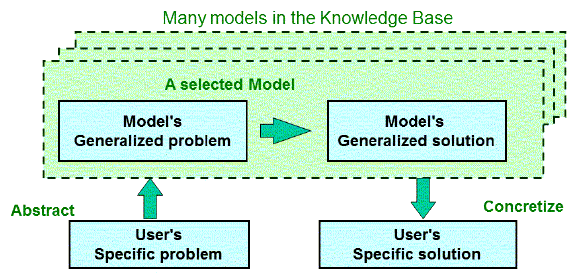
Figure 1. 'Four-Box Scheme' of problem solving with abstraction
(6) Approaches to 'analyze' the problem deeply have been in progress. Examples of analysis are: How, or in which mechanism, is the present system working? What are the root causes of the problems (or undesirable effects)? What are characteristic features in time and in space? How the functions and properties of various components in the system are related to the mechanism and to the problem? etc.
-- The analysis approach sometimes seems to be tedious and circuitous, but still is the orthodox way in science and technology. It is usual that analyzing things guides you to the understanding of their reality.
(7) Another important approach is to clarify what you desire by solving the problem. The image of 'Ideal situation' is more important than the task at hand. Several methods have been developed in this approach.
-- This is also an important process for converting the understanding of the problem in the present situations into ideas of desirable solutions.
(8) There also exist some approaches to think of full and consistent processes for problem solving and task achieving. Some of them try to combine multiple techniques in steps and some others try to make a simple and concise process by selecting only several essential modules.
-- The present study is an extension of this approach.
As reviewed briefly above, the focus of the studies in this field have evolved from 'enlightenment' and 'idea generation in one step' to the more sophisticated process of close analysis of the problem, making an image of ideals, and generating ideas. The crucial task for us is to construct a 'framework' of the whole process of problem solving and task achieving and integrating different conventional methods.
3. 'Framework' of the whole process of creative problem solving and task achieving: A new paradigm, the 'Six-Box Scheme'
The present study proposes to establish a 'framework' of the general processes of 'creative problem solving and task achieving', and to adopt the 'Six-Box Scheme' as the framework.
The 'Six-Box Scheme' was originally recognized [2] as the framework of USIT (pronounced like 'you sit'; Unified Structured Inventive Thinking), which is a streamlined, easy-to-learn-and-apply process derived from TRIZ. It became clear when the flowchart of USIT process was redrawn in a data-flow diagram, where information necessary in each stage is described. The 'Six-Box Scheme' is illustrated in Figure 2.
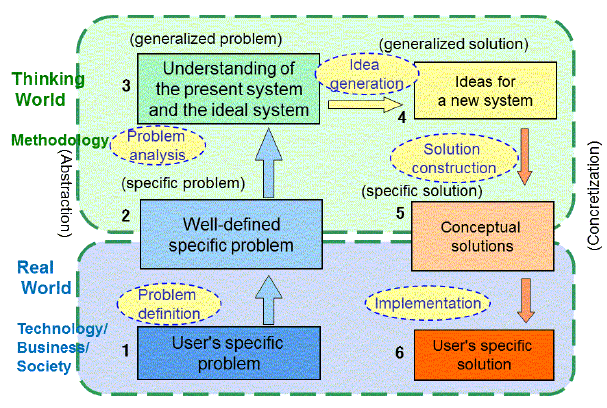
Figure 2. 'Six-Box Scheme' for creative problem solving
The lower half of the figure belongs to the 'Real World', where technologies, businesses, societies, etc. have their activities and carry out various processes using their own criteria of values. The upper half, on the other hand, belongs to the 'Thinking World' of creative problem solving, where the thinking methods are prevailing. The 'Six-Box Scheme' distinguishes these two worlds and assigns them separately different stages and roles of problem solving.
In the 'Real World', the initial 'User's specific problem' (Box-1, bottom-left) is examined to clarify what they really want to solve and is represented in the form of 'Well defined user's specific problem' (Box-2) to be passed to the 'Thinking World'.
Then in the 'Thinking World', the problem (Box-2) is analyzed to obtain the 'Understanding of the present system' and the 'Understanding of the ideal system' (Box-3). (Note: the word 'system' here means the whole object to think about in the problem.) For understanding the present system with a problem, we use the concepts such as components of the system, the attributes (or properties) of components, functional relationships, characteristics in space and in time, working mechanism, root causes of the problem, contradictions, etc. It is important to obtain the understanding of the ideal system also in this stage (Box-3).
Next we obtain 'Ideas for the new system (Box-4)'. They are neither items from random thoughts nor simple suggestions as hints, but they are ideas such as "let's revise a certain component of the present system in such a manner", "let's introduce the xx mechanism here", etc.
'Solution concepts' (Box-5) are built next around the core ideas (Box-4). They are the final results of the 'Thinking World' and are to be proposed to the 'Real World' saying "These solutions should work well and solve the problem effectively."
In the 'Real World', the solution concepts (Box-5) need to go through various processes further to be implemented in the 'User's specific solution' (Box-6) in real products, services, etc.
As explained above, the Box-3 and Box-4 of the 'Six-Box Scheme' are quite different from the generalized problem and generalized solutions in the models of the conventional 'Four-Box Scheme'. The 'Six-Box Scheme' can describe what types of information are requested in Box-3 and how they can be obtained along the thinking process. Such an explanation may be general and detailed and easy to understand. Further to our fortune, the human brains work actively during the analysis process to understand the present and ideal systems (Box-3) and naturally generate many good ideas (in Box-4) spontaneously as the results of small-step 'Enlightenments'.
It is also important that the 'Six-Box Scheme' clearly shows the activities necessary in the 'Real World', i.e., the preceding activities for 'Defining the problem' (from Box-1 to Box-2) and the succeeding activities for 'Implementing the solutions' (from Box-5 to Box-6). In fact, for creative problem solving projects, it is crucial to decide 'what problems/tasks we should work on', and is even more important to 'implement the results of the thinking project into real products/services and make benefits from them as a business'. Such important activities should be carried out in the 'Real World' by their own decision making under their criteria of values, the 'Six-Box Scheme' tells.
4. How to construct the 'General methodology of creative problem solving and task achieving' (CrePS)
Now let us think how to construct the 'General methodology of creative problem solving and task achieving' by introducing the 'Six-Box Scheme' as the framework and integrating many conventional studies of different approaches [3, 4]. Even though the present study is just at the initial stage, I have found the following strategies. (Note: 'General methodology of creative problem solving and task achieving' is abbreviated as CrePS. )
(a) The main part of CrePS concerns with the thinking process from Box-2 to Box-3, to Box-4, and finally to Box-5 in the 'Thinking World' in the 'Six-Box Scheme'. In addition, we need to build the initial part of CrePS from Box-1 to Box-2 for problem definition and also the succeeding part of CrePS from Box-5 to Box-6 for implementing the solutions.
(b) On the basis of the data-flow representation concept, we should specify the information necessary to obtain in each stage of the process. As a result, we can describe many different methods from a consistent perspective and can understand the existence of different ways of obtaining and representing similar information.
(c) We should build CrePS for technological fields and CrePS for non-technological fields (where humans, organizations, societies, etc. are involved) in a parallel manner. The frameworks of the two are essentially the same, but in the non-technological fields we need to handle differences of values and intentions among people and the problems are often bigger, more complex and delicate.
(d) The main part of CrePS can be supported by many studies of 'Creativity methods', and 'Problem solving methods', including TRIZ/USIT; thus we are going to organize the descriptions of TRIZ/USIT first, and then add the descriptions of other methods.
(e) The initial part of CrePS holds a large variety of research topics. During various activities in the 'Real World', when we encounter some difficulties we need creative problem solving and task achieving, i.e. the chance of using CrePS methodology. Hence we need to clarify what we should do in such various cases. We should classify the purposes and situations, find some suitable methods to be used for each type of purpose/situation, and then specify how to transfer from the method to the main part of CrePS process. A large variety of conventional methods exist, and recently TRIZ is contributing to the studies in this stage of problem solving.
(f) The succeeding part of CrePS has different situations of research and practice. For implementing solution concepts, various engineering methods have been established already in each discipline, and digital engineering techniques, optimization methods, parameter design (Taguchi method), etc. are used. Research topics related to CrePS are to clarify how to implement the solution concepts surely into the products/services, how to make them profitable in the business, and how to make it possibly an innovation. They are important and difficult research topics for business management, rather beyond technology.
(g) Building up such a system of methodology is a task beyond the power of a few individuals. It is much desirable for many researchers of different methods cooperate to form a consensus and to build the CrePS methodology.
5. The initial part of the CrePS methodology
The initial part of CrePS means all the processes to be done in the 'Real World' before starting a creative problem-solving/task-achieving job on a certain theme with the CrePS methodology in the 'Thinking World'. Since we are going to apply the CrePS methodology to the job, the CrePS methodology itself must be established beforehand. The requirements to the initial part of CrePS are summarized in Table 2.
Table 2. Initial part of CrePS (Technological) (in the 'Real World')
(0) Basic targets of CrePS |
|
Basic targets |
|
Applicable to technological problems |
|
Applicable to wide ranges of science and tech. |
|
Using information from science & tech. and patents |
|
Possible to use methods in different specialty fields |
(1) Grasping problems in the real world and preparing for creatively solving them (Box-1) |
|
Bases of problem awareness and proactiveness |
|
Grasping a problem and surveying the situations |
|
Clarifying the real problem to be addressed |
(2) Connecting tech. development with CrePS (Box-2) |
|
Considering on future trends and needs |
|
Planning new products and services |
|
Need to develop a new technology |
|
Need to solve a technological difficulty |
|
Problem solving in the function/performance aspect |
|
Problem solving in the quality aspect |
|
Problem solving in the cost and delivery aspect |
|
Problem solving at the mature stage of S-curve |
|
Planning a large-scale new system/service, etc. |
(3) Connecting tech. dev. methods with CrePS (Box-2) |
|
Methods for future foreseeing |
|
Methods for considering the customer needs |
|
Methods for analyzing problem situations |
|
Methods for facilitation |
|
Methods for generating/circumventing patents |
|
Methods for risk management |
|
Methods for deciding the directions of R&D. |
|
Methods for organizing technological policies |
(4) Connecting education with CrePS |
|
For children (joy of thinking and trying for oneself) |
|
For high school students (basics of prob. solving) |
|
For university students (basics of CrePS) |
|
For engineers (training of CrePS) |
|
In engineering jobs (using CrePS regularly) |
|
In advanced R&D (performing CrePS) |
|
For citizens (applying to problem solving) |
|
Proliferation through publications, TVs, internets |
|
Promotion by government and public organizations |
(5) CrePS itself being established |
|
Concept and vision of CrePS |
|
Method of constructing CrePS |
|
Cooperating people for establishing CrePS |
|
Contents of CrePS |
|
Textbooks |
|
Teaching methods |
|
Methods of practical use of CrePS |
|
Examples of practical use with success |
|
Acceptance in academia and by professional people |
|
Usage in industries with success |
(6) Starting CrePS projects (for working in the 'Thinking World') |
|
Starting a CrePS project as a job in an industry, etc. |
|
Teaching CrePS in a university, etc. |
|
Practice and training of CrePS in a university, etc. |
In item (0) 'Basic targets of CrePS', our general target is declared as: "To establish a general methodology of creative problem-solving/task-achieving, to spread it widely, and to apply it to problem-solving and task-achieving jobs in various domains in the whole country (and the world)".
Item (1) describes the basic attitude for recognizing a problem and some general process for finding the core problem to be solved.
Item (2) describes possible ways of using the CrePS methodology in various stages of product/technology development, and Item (3) lists up possible ways of connecting with various methods used for different purposes in such stages.
Item (4) mentions about education and proliferation to different types of people, e.g., from children to engineers, from academic researchers to ordinary citizens in society.
As described in Item (5), the CrePS methodology must be established well for fulfilling these possible application needs. It should have good textbooks and well written case studies. And establishing such a methodology can be realized only by the cooperative work by a large number of researchers and promoters in different fields.
Item (6) describes how to start, in the 'Real World', an individual CrePS project which is going to work along the main part of CrePS shown in the next section.
6. The main part of CrePS methodology
The main part of CrePS is composed in a step-wise and hierarchical manner, as shown in Table 3. Items in the table are expressed as 'doing something' but emphasis is on the information to be obtained and clarified. Details of component methods and their references are not shown here because of the limitation in space. Without repeating the contents in the table, some remarks on the points which are apt to be missed are written here.
Table 3. Main part of the CrePS methodology (Technological) (in the 'Thinking World')
(0) The whole process |
|
Systematic/compound whole processes |
|
Simplified/customized whole processes |
(1) Grasping the problem (Box-2) |
|
Setting up the project |
|
Grasping the problem in a systematical way |
|
Setting up the purposes and tasks |
|
Considering in a wider scope |
|
Setting the focal points |
|
Understanding the resources and constraints |
(2) Understanding the present system (Box-3) |
|
Understanding the difficulties and the root causes |
|
Understanding the mechanism of the present system |
|
Understanding the functions and attributes |
|
Understanding the space and time characteristics |
|
Clarifying the difficulties and contradictions |
|
Examining various existing methods |
|
Surveying similar tasks and their solutions in different areas |
(3) Getting images of the ideals (Box-3) |
|
Methods of getting images of the ideals |
|
Considering desirable behaviors and properties |
|
Considering the directions of evolution |
(4) Generating ideas (Box-4) |
|
Techniques for generating ideas |
|
Generating ideas by the help of hints and guide lines |
|
Generating ideas which solve contradictions |
|
Generating ideas systematically and exhaustively |
|
Identifying good ideas. |
(5) Constructing conceptual solutions (Box-5) |
|
Extending the ideas |
|
Building improved solutions by introducing the ideas |
|
Introducing good solutions from different areas |
|
Designing new solutions |
|
Solving secondary problems |
|
Evaluating and identifying good solutions |
|
Writing reports and proposals of the CrePS project |
The table lists up various sub-processes which are desirable in different situations in the order effective to perform in many cases. This is the image of the 'systematic/compound whole process' of CrePS as written in the first line of Step (0). Actual use of CrePS is often carried out in a simpler way by selecting necessary sub-processes depending on the problem situations and the targets of the CrePS projects. Such a usage is called 'Simplified/customized whole process' of CrePS.
The process (1) 'Grasping the problem (Box-2)' should be done previously in the initial part of CrePS in the 'Real World', but must be done here again by the CrePS project team for confirming the problem situations and the project targets. This problem definition step is crucial. Insufficient definition of the problem may make all the later efforts for solving the problem into waste.
In process (2) 'Understanding the present system (Box-3)', a number of standard ways of analysis are listed up. Last two sub-processes saying 'Examining various existing methods' and 'Surveying similar tasks and their solutions in different areas' advise to look around various information outside without concentrating too much in the own specific system and problem.
In process (3) 'Getting images of the Ideals (Box-3)', a sub-process 'considering the directions of evolution' gives a similar suggestion for seeing outside.
In process (4) 'Generating ideas (Box-4)', sub-processes written in the latter half need to be remarked, i.e. 'Generating ideas which solve contradictions', 'Generating ideas systematically and exhaustively', and 'Identifying good ideas'.
In process (5) 'Constructing solutions (Box-5)', capability in the subject fields of the possible solutions plays more important roles than the capability in the CrePS methods. At the final stage, the CrePS project must prepare for the report and give presentations and proposals to the managers and the parent project in the 'Real World'.
7. Succeeding part of CrePS
The succeeding part of CrePS means, in the 'Six-Box Scheme', all the processes for implementing 'Solution concepts (Box-5)' into 'User's specific solutions (Box-6)' in the 'Real World'. The 'Solution concepts' are produced by the CrePS project team which worked in the 'Thinking World'. But the subsequent processes for implementing them should be carried out in the 'Real World' by the 'parent project', which requested the problem solving, under the support by corporate activities.
Table 4. Succeeding part of CrePS Process (Technological) (in the 'Real World')
(0) Basic outputs of CrePS |
|
Contents of basic outputs (Box-2 to Box-5) |
|
Documents of the CrePS project |
(1) Reporting and accepting the CrePS project outputs |
|
Reporting the results of the CrePS project |
|
Accepting the report of the CrePS project |
|
Treating the outputs of the CrePS project |
|
Reporting the results of the CrePS education/training |
|
Treating the results of CrePS education/training |
(2) Evaluating the solution concepts (Box-5) |
|
Initial evaluation of the new conceptual solutions |
|
Evaluation criteria in the 'Real World' |
|
Evaluation in the aspects of patents |
|
Directions of the parent project and the new solutions |
(3) Extending them to build new solution plans |
|
Acquiring technical information |
|
Introducing new technology |
|
Directions of the parent project and the new solutions |
(4) Implementing into actual solutions (Box-6) |
|
Designing, prototyping, etc. |
|
Active use of digital technology |
|
Parameter design and optimization |
(5) Examining the new solutions |
|
Examining the new solutions in the industry |
|
Deciding the treatment of the new solution |
(6) Manufacturing, Marketing, etc. (Box-6) |
|
Further steps for manufacturing, marketing, etc. |
Item (0) remarks that the basic outputs of the CrePS project are not only the 'Solution concepts (Box-5)' but also all the intermediate information produced and recorded along the CrePS methodology, i.e. 'Well-defined user's specific problem (Box-2)', 'Understanding of the present and ideal systems (Box-3)' and 'Ideas for a new system (Box-4)'.
The CrePS project should prepare a report containing all such basic outputs and present it to the manager of the parent project, who is responsible in the 'Real World'. The person who receives the report should understand how the CrePS project worked to get the outputs, and evaluate the 'Solution concepts' (Box-5) and make decisions on subsequent treatment.
For implementing the new solution concepts finally into commercial products/services, many processes as written in Items (2) through (6) are necessary; they need a lot of corporate activities, mostly less relevant to the CrePS methodology.
8. Future perspectives
As described above, conventional studies on 'creativity methods', 'methods of problem solving', etc. are apt to be partial in their scope and are promoted separately resulting in difficulties in the practice and proliferation. The present paper has pointed out that the root cause of the difficulties is the lack of a proper framework for integrating many different methods.
By introducing the 'Six-Box Scheme' (Fig. 2) as the framework, many different methods of 'creative problem solving and task achieving' can be integrated into a general and unified methodology, named CrePS ('General methodology of creative problem-solving and task-achieving'), as shown in Tables 2 to 4.
The present paper proposes to achieve the following general target by the cooperation of you and many other people:
"To establish a general methodology of creative problem-solving / task-achieving,
to spread it widely, and
to apply it to problem-solving and task-achieving jobs in various domains in the whole country (and the world)"
The present author sincerely wishes the readers to understand the vision and cooperate for achieving the general target together.
References
[1] Toru Nakagawa: 'Establishing general methodologies of creative problem-solving / task-achieving: Beyond TRIZ', Presented at ETRIA TRIZ Future Conference 2012, Oct. 24-26, 2012, Lisbon, Portugal; "TRIZ Home Page in Japan", Dec. 2012 (in English and in Japanese)
[2] Toru Nakagawa: 'A New Paradigm for Creative Problem Solving: Six-Box Scheme in USIT without Depending on Analogical Thinking', Presented at the 27th Annual Conference of the Japan Creativity Society, October 29-30, 2005, Tokyo; "TRIZ Home Page in Japan", Nov. 2005 (in Japanese); "TRIZ Home Page in Japan", Apr. 2006 (in English)
[3] Makoto Takahashi, ed., "The Bible of Creativity", New edition, Nikka-Giren Publishers, 482 pages (2002) (in Japanese)
[4] Toru Nakagawa: 'For Establishing General Methodology of Creative Problem Solving & Task Achieving', Presented at 3rd Forum on Knowledge Co-Creation, March 2-3, 2013, Tokyo; "TRIZ Home Page in Japan", Jun. 2012 (in Japanese and in English)
Note: "TRIZ Home Page in Japan": http://www.osaka-gu.ac.jp/php/nakagawa/TRIZ/ (in Japanese);
http://www.osaka-gu.ac.jp/php/nakagawa/TRIZ/eTRIZ/ (in English)
 Presentation slides (ETRIA TFC2013) Slides PDF
Presentation slides (ETRIA TFC2013) Slides PDF 
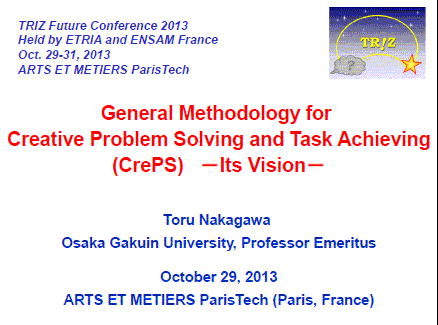
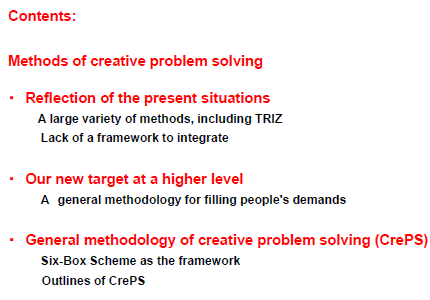
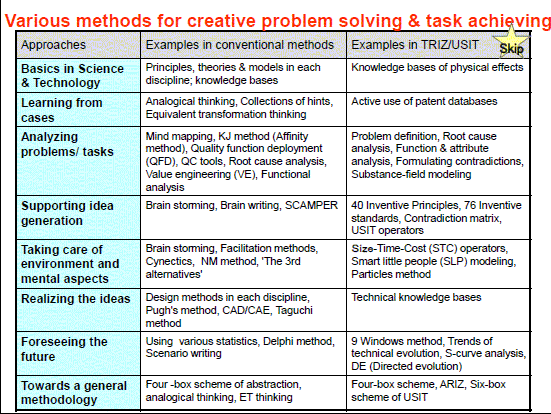
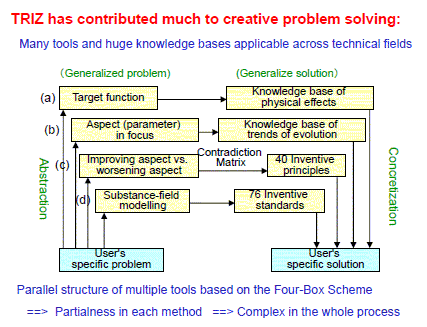
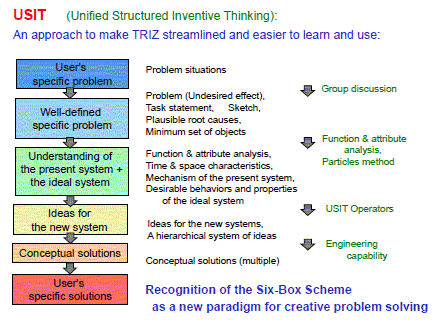
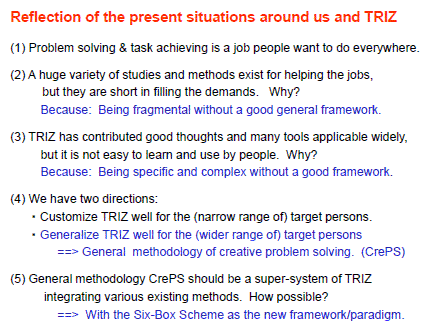
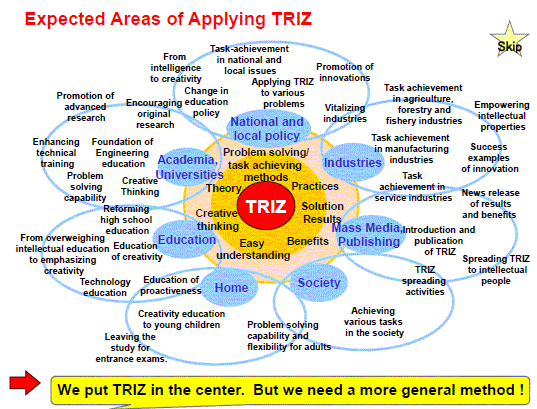
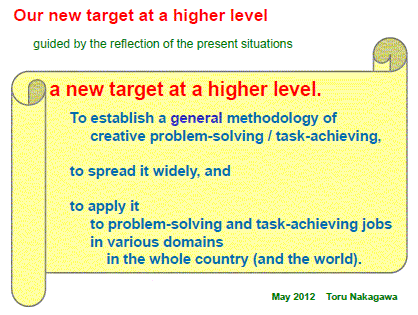
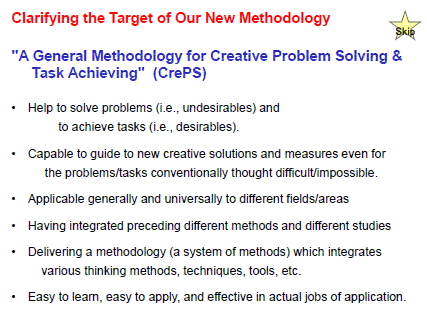
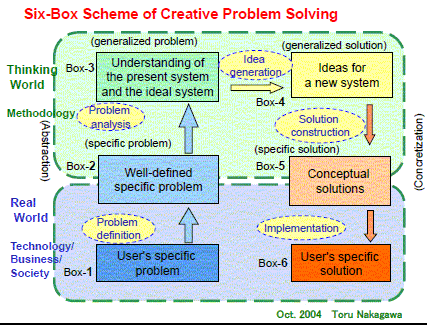
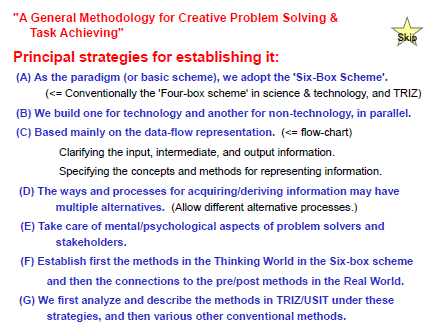
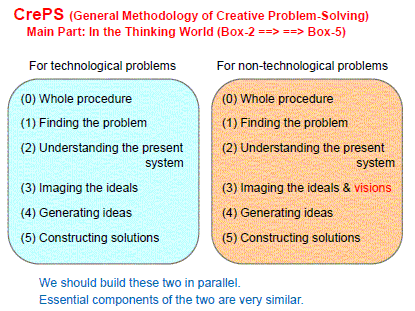
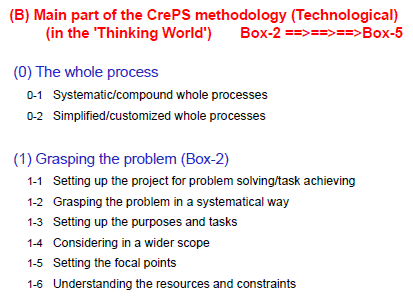
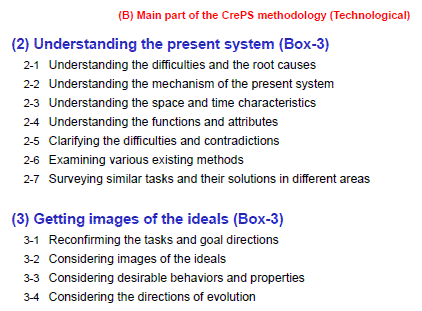
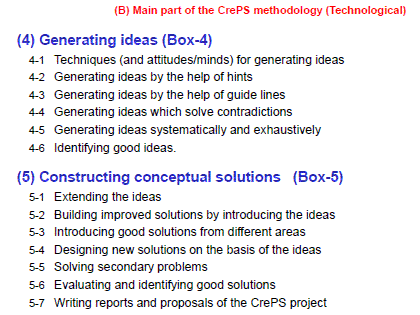
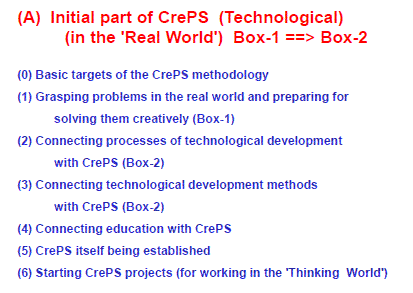
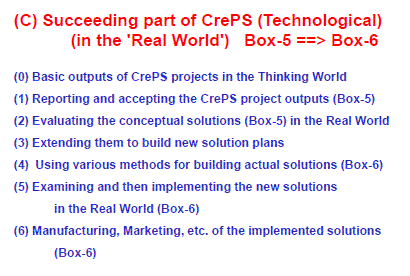
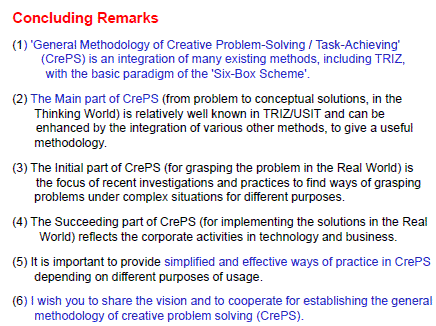
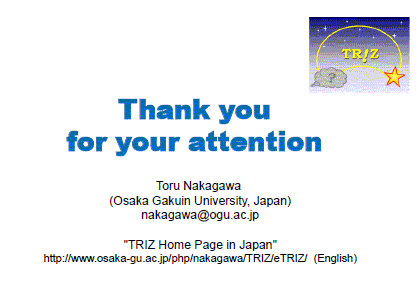
 Japanese page
Japanese page  Paper (JCS Conf.) HTML
Paper (JCS Conf.) HTML  PDF
PDF
Slides (JCS Conf.) HTML  PDF
PDF
Last updated on Oct. 25, 2013. Access point: Editor: nakagawa@ogu.ac.jp




















